July, 2019

Got Sobralia?
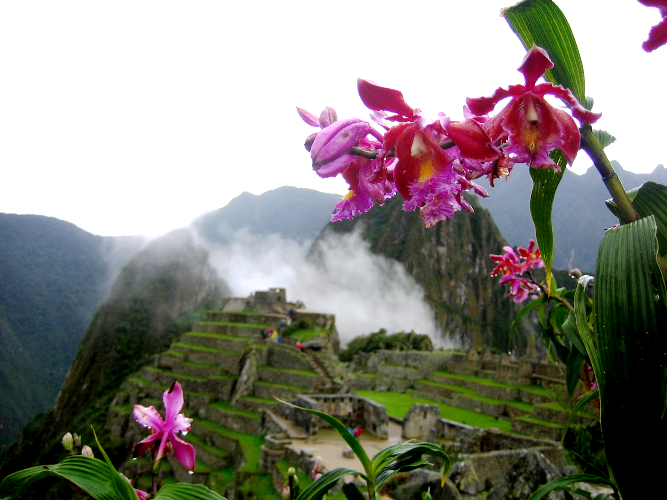
Sobralia dichotoma at Machu Piccho, Peru
In many parts of Latin America, Sobralia is a common plant along the roadsides. Along the highways in Costa Rica, the roadsides are mowed periodically, but Sobralia, usually with either white or lavender flowers, grows back quickly, along with the usual grasses, Impatiens, ferns, etc. Travelers often notice these big, cheerful flowers that look a lot like Cattleyas, even though they really belong with Elleanthus in the Maxillaria tribe. Away from the roadsides, at least 150 species of Sobralia have been described from near sea level to at least 8,000 ft, in a variety of habitats. They include "the world's tallest orchid", Sob. altissima from the mountains of Peru; one of these plants was measured at over 44 ft. in height, although they are usually "only" about 20 ft. There are also some relative miniatures, about a foot tall, such as Sob. callosa. In between, surprising diversity. Perhaps this another of those "something-for-everyone" orchids that we should all be growing.
World's tallest orchid, Sobralia altissima. Not mentioned is how this photo was taken, if the plant was indeed 20 feet
tall!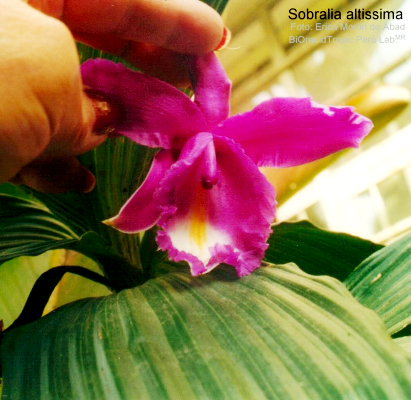
Sobralia grows terrestrially, for the most part. The species and hybrids that we find at our local orchid nurseries (Andy's Orchids has a group of them near the entrance) appear to grow happily outdoors in big tubs of bark and perlite, and when they get overgrown, the canes can be cut down and new ones will quickly sprout. The canes keep their leaves throughout the year, until the cane finally dies back after several years. Repotting isn't as difficult as you might expect, it does not seem to be necessary, or even desirable, to remove the old medium (some species don't like to have their roots disturbed). Rather, just clean up the root ball and gently remove or hose off anything especially rotten, and then place it back in a suitable pot and fill in with fresh medium as you would do with any other orchid. The roots are usually large and vigorous, and new canes sprout easily from the underground stem. They like a lot of water during the growing season.
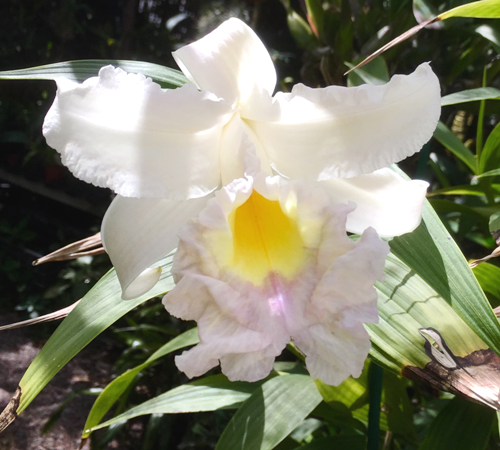
Sob. Mirabilis 'Luna Nueva' grows in Long Beach, only pest seems to be something like mealybugs in the growing tips of the canes
Flowers are produced usually one at a time (clusters in some species) at the ends of the canes. The flowers often last just a day or two, but this varies with the species. Flowers of many species are unexpectedly large! Many colors are available, mostly in the white-pink-lavender range, but also some yellows, contrasting lips, etc.
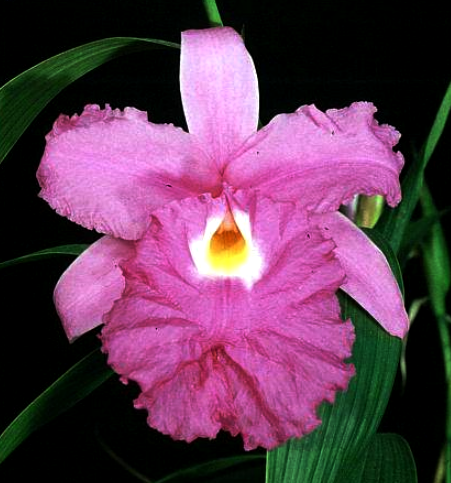
Sob. macrantha 'Voodoo Priestess' AM/AOS, exhibited in 1996 at SCOS judging center by member Neal Crosswhite
The main drawback for growing Sobralias in our area seems to be that, when they bloom, they are too big to transport to our meetings and judging center. Nevertheless, someone manages to bring in a specimen plant from time to time. Another difficulty is that they can take up a lot of space! With a little thought and experience, however, most of us can probably grow a few of them, almost as a hedge along a fence or wall, or as a screen between sections of the garden. A big plant with many canes will likely produce a few flowers, one at a time, on several canes, off and on through the summer. For the rest of the year, the canes are not unattractive, the bright green leaves are pleated and well arranged.
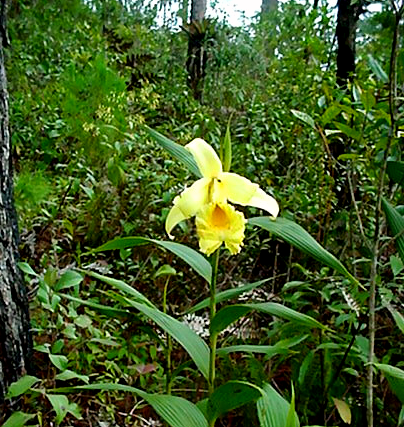
Sobralia xantholeuca in situ in Chiapas, Mexico
Besides the species available at Andy's Orchids, and the hybrids offered by Cal-Orchid, another notable source is Ecuagenera, based in Cuenca, Ecuador. Owner Pepe Portilla offers over a dozen species on his web site, and he brings a wide selection of orchid plants (all bare-root) to the major sales and shows in Southern California (usually the shows at Santa Barbara, the Huntington show, and the Fascination of Orchids sale).
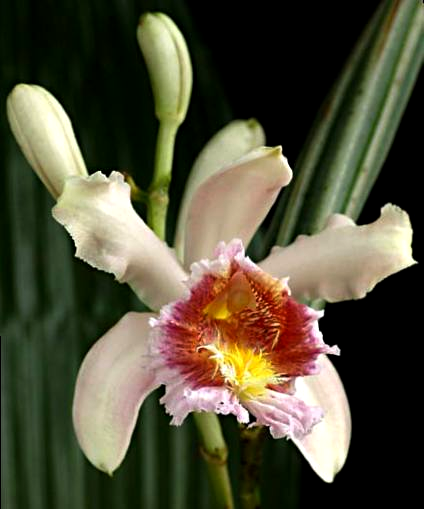
Sobralia mutisii
Enter the taxonomists: Sobralia has not escaped their attention! The genus has long been divided into "sections" (with Latin names). Recently, a study that included DNA sequence analysis (of only 3 genetic markers, however) produced evidence that the section that includes the type species Sob. dichotoma (the one photographed at Machu Picchu, at the top of this article) is quite dissimilar to the other sections (Przemyslaw Baranow, Magdalena Dudek, and Dariusz L. Szlachetko, 2017, Brasolia, a new genus highlighted from Sobralia (Orchidaceae), Plant Systematics and Evolution 303:853-871).
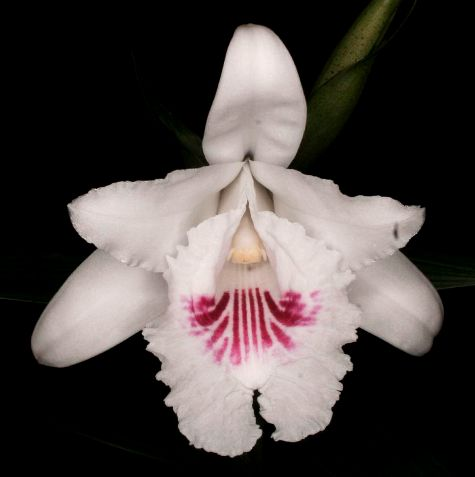
Sobralia pulcherrima
One option for how to proceed in the face of this evidence would be to follow the normal rules of plant taxonomy, and leave the section including Sob. dichotoma alone, and then to transfer the remaining 140 or so species to a new genus Cyathoglottis, the oldest available synonym of Sobralia. However, observing with masterful understatment that "such a reorganization could cause confusion", another proposal, originally made by Dressler, was to designate another species as the type for Sobralia, so that the bulk of the species would remain under that name. In the article cited, we read, and apparently this statement was not intended to be ironic, "Unfortunately, no further nomenclatural changes within the genus have been made since the publication of the proposal by Dressler et al. (2011)". Accordingly, these authors have advanced the notion that the type section of the current Sobralia should be split out under Brasolia, one of the old synonyms of the genus Sobralia, and, if the proposal were approved by the Nomenclature Committee for Vascular Plants in 2017, everybody could go home happy. Whether the decision was actually accepted, we haven't yet discovered, the report from that meeting has not yet appeared on the internet.
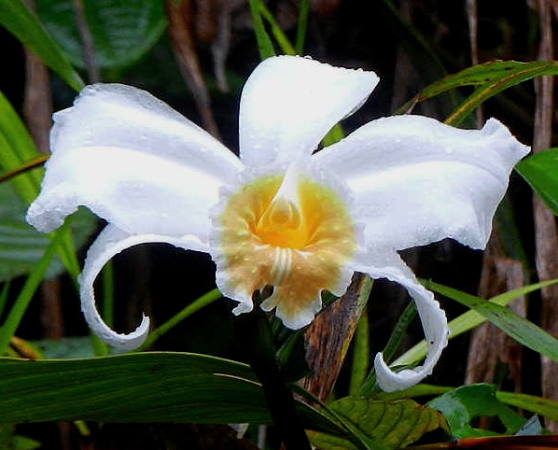
Sobralia citrea
The orchids are now a playground for the taxonomists, but that is not necessarily a bad thing. True, the names change faster than anyone can keep up with them, possibly including other taxonomists, and if these changes are done too quickly, they may have to be undone (as has happened with a number of taxonomic adventures among the birds). But it is probably better that all available species are studied by modern methods. Without active study, it is entirely possible that no one will realize how close some of them may be to extinction from habitat loss, or just how rare some specimens in captivity may actually be.